Leadership: Theories, Practices, and Impact on Organizational Goals
VerifiedAdded on 2023/01/05
|15
|1973
|29
Report
AI Summary
This report provides a comprehensive overview of leadership, encompassing various theories, styles, and practical applications. It begins by defining leadership as a process of influencing others toward a shared goal, distinguishing between leaders and managers, and exploring different leadership styles. The report delves into motivational theories, such as Maslow's hierarchy of needs, and examines the use of power and influence, including the Pygmalion effect. It further explores contingency theory and normative decision-making models, highlighting the importance of situational awareness and team participation. Additionally, the report addresses leadership's role in change management, the dark side of leadership, and the characteristics of effective followers. It concludes with a discussion of leadership in the context of groups and teams, emphasizing the impact of group size and team dynamics on leadership effectiveness.
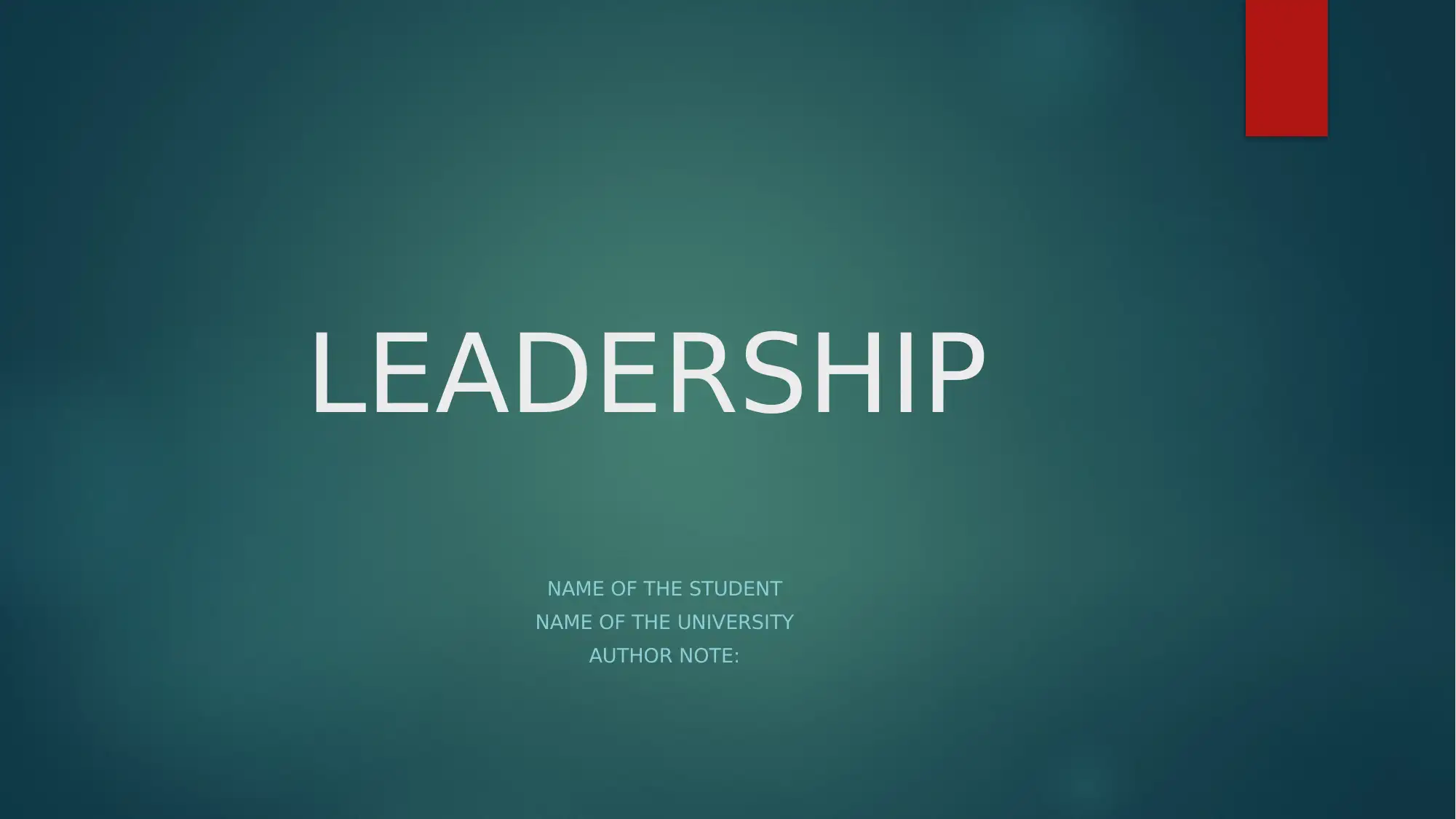
LEADERSHIP
NAME OF THE STUDENT
NAME OF THE UNIVERSITY
AUTHOR NOTE:
NAME OF THE STUDENT
NAME OF THE UNIVERSITY
AUTHOR NOTE:
Paraphrase This Document
Need a fresh take? Get an instant paraphrase of this document with our AI Paraphraser
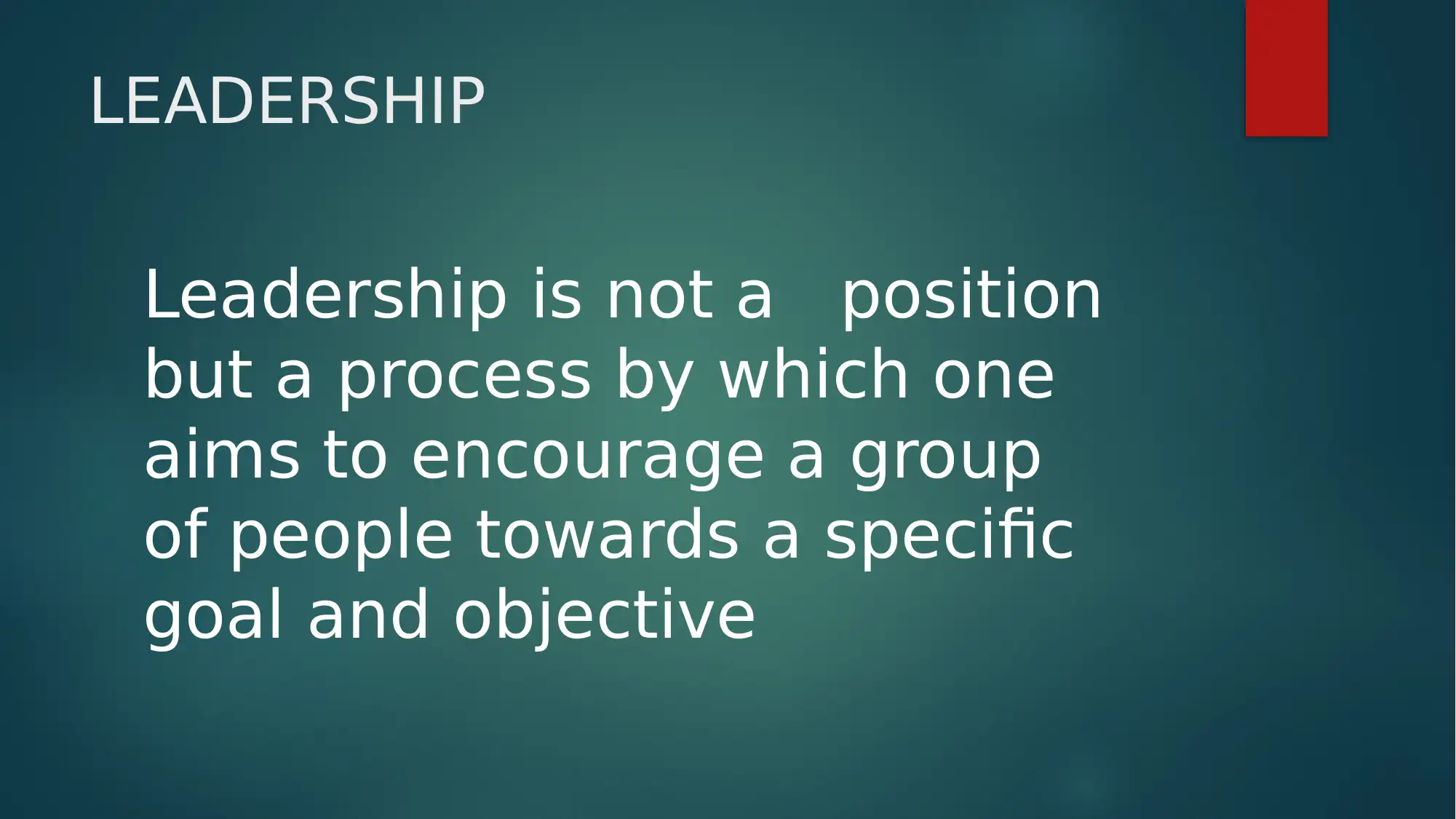
LEADERSHIP
Leadership is not a position
but a process by which one
aims to encourage a group
of people towards a specific
goal and objective
Leadership is not a position
but a process by which one
aims to encourage a group
of people towards a specific
goal and objective
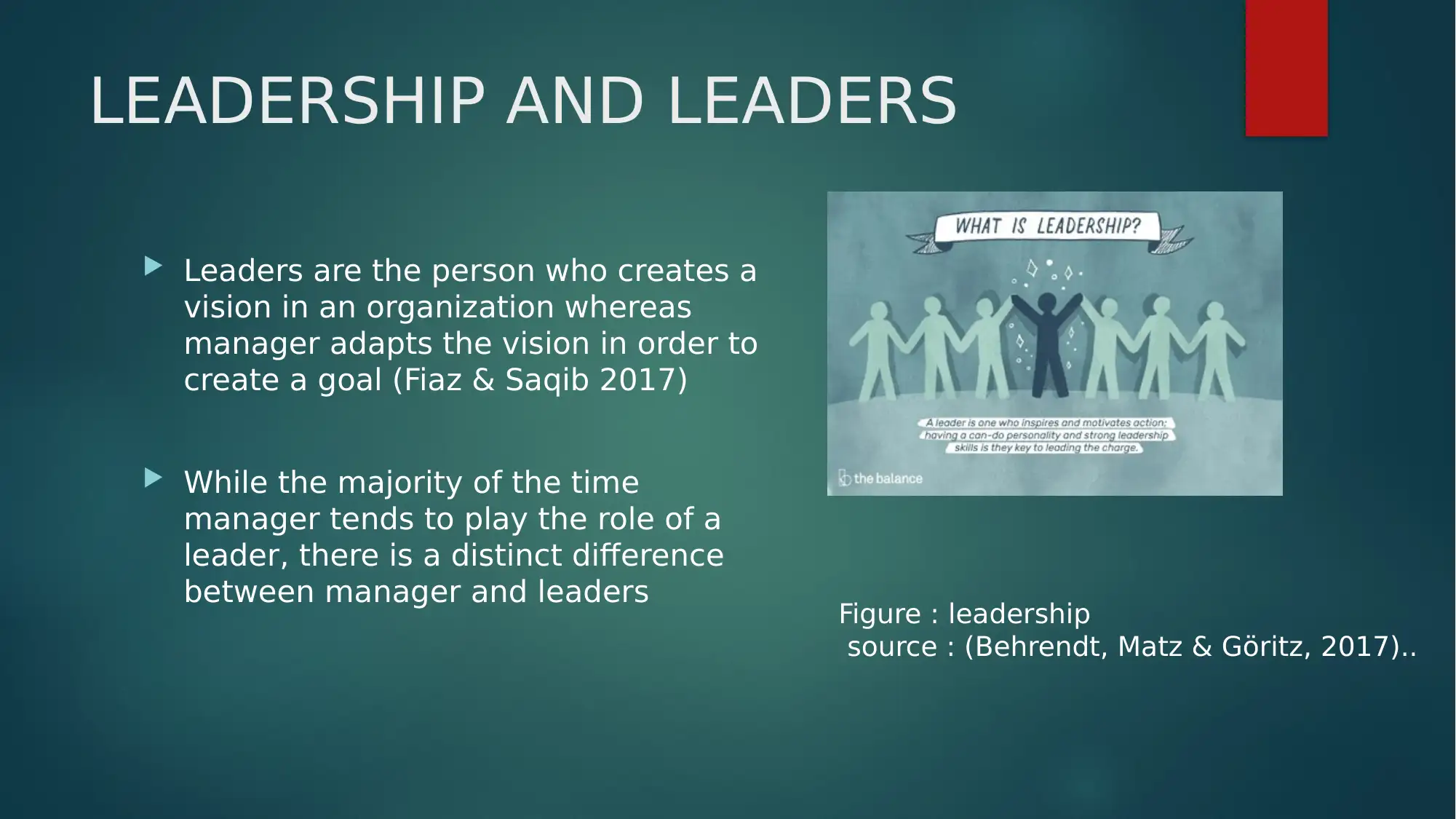
LEADERSHIP AND LEADERS
Leaders are the person who creates a
vision in an organization whereas
manager adapts the vision in order to
create a goal (Fiaz & Saqib 2017)
While the majority of the time
manager tends to play the role of a
leader, there is a distinct difference
between manager and leaders Figure : leadership
source : (Behrendt, Matz & Göritz, 2017)..
Leaders are the person who creates a
vision in an organization whereas
manager adapts the vision in order to
create a goal (Fiaz & Saqib 2017)
While the majority of the time
manager tends to play the role of a
leader, there is a distinct difference
between manager and leaders Figure : leadership
source : (Behrendt, Matz & Göritz, 2017)..
⊘ This is a preview!⊘
Do you want full access?
Subscribe today to unlock all pages.

Trusted by 1+ million students worldwide
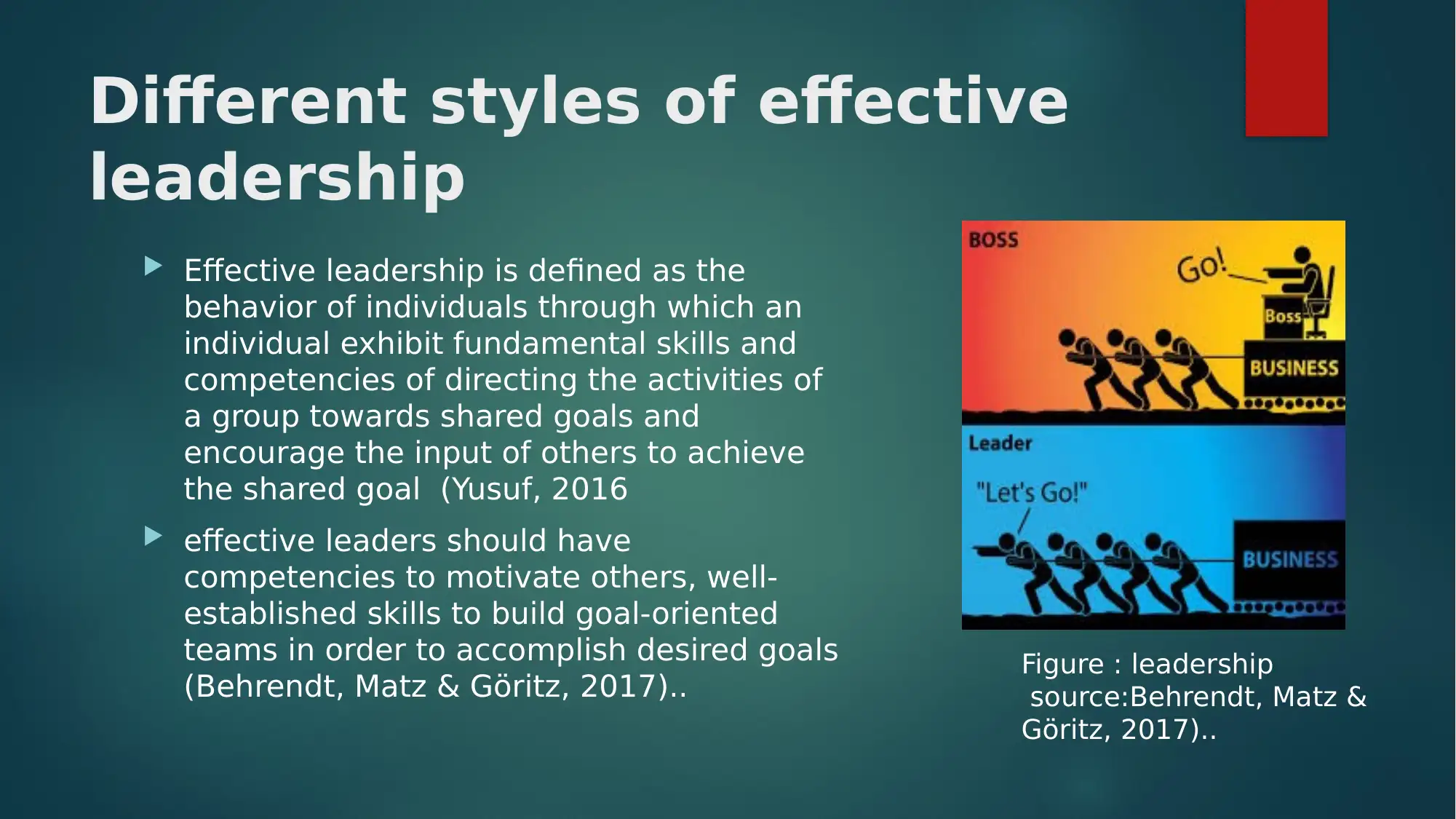
Different styles of effective
leadership
Effective leadership is defined as the
behavior of individuals through which an
individual exhibit fundamental skills and
competencies of directing the activities of
a group towards shared goals and
encourage the input of others to achieve
the shared goal (Yusuf, 2016
effective leaders should have
competencies to motivate others, well-
established skills to build goal-oriented
teams in order to accomplish desired goals
(Behrendt, Matz & Göritz, 2017).. Figure : leadership
source:Behrendt, Matz &
Göritz, 2017)..
leadership
Effective leadership is defined as the
behavior of individuals through which an
individual exhibit fundamental skills and
competencies of directing the activities of
a group towards shared goals and
encourage the input of others to achieve
the shared goal (Yusuf, 2016
effective leaders should have
competencies to motivate others, well-
established skills to build goal-oriented
teams in order to accomplish desired goals
(Behrendt, Matz & Göritz, 2017).. Figure : leadership
source:Behrendt, Matz &
Göritz, 2017)..
Paraphrase This Document
Need a fresh take? Get an instant paraphrase of this document with our AI Paraphraser
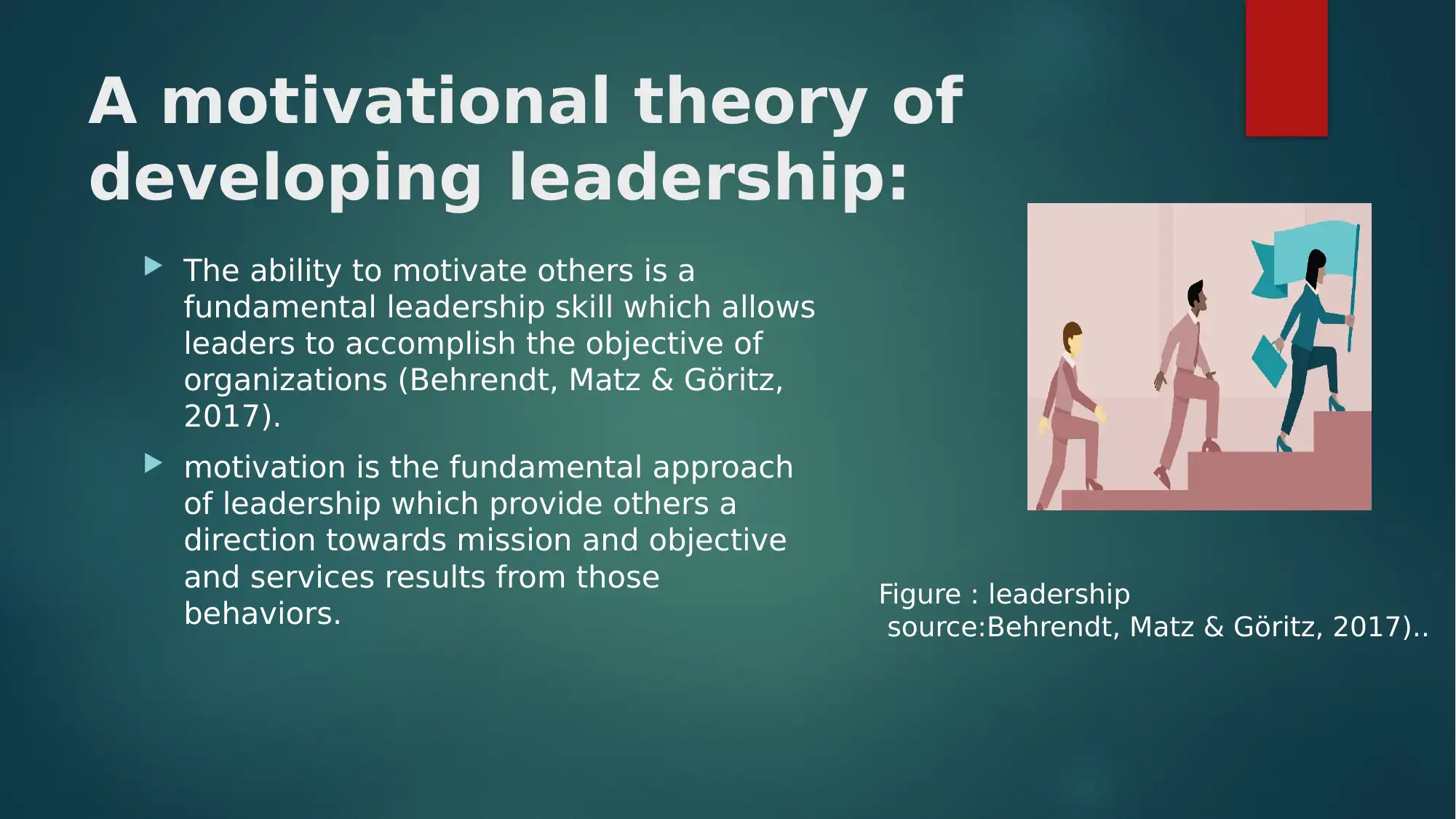
A motivational theory of
developing leadership:
The ability to motivate others is a
fundamental leadership skill which allows
leaders to accomplish the objective of
organizations (Behrendt, Matz & Göritz,
2017).
motivation is the fundamental approach
of leadership which provide others a
direction towards mission and objective
and services results from those
behaviors. Figure : leadership
source:Behrendt, Matz & Göritz, 2017)..
developing leadership:
The ability to motivate others is a
fundamental leadership skill which allows
leaders to accomplish the objective of
organizations (Behrendt, Matz & Göritz,
2017).
motivation is the fundamental approach
of leadership which provide others a
direction towards mission and objective
and services results from those
behaviors. Figure : leadership
source:Behrendt, Matz & Göritz, 2017)..
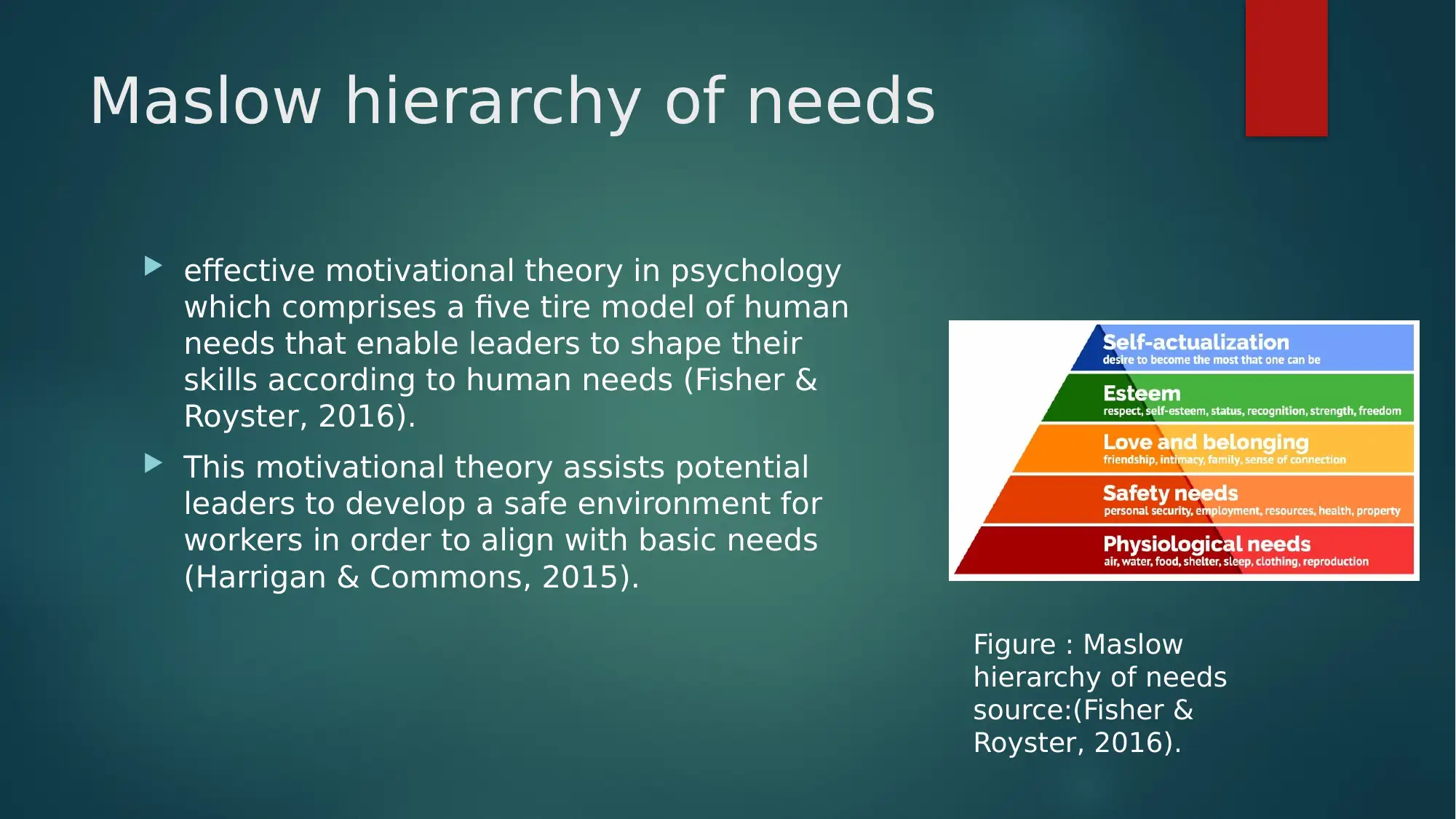
Maslow hierarchy of needs
effective motivational theory in psychology
which comprises a five tire model of human
needs that enable leaders to shape their
skills according to human needs (Fisher &
Royster, 2016).
This motivational theory assists potential
leaders to develop a safe environment for
workers in order to align with basic needs
(Harrigan & Commons, 2015).
Figure : Maslow
hierarchy of needs
source:(Fisher &
Royster, 2016).
effective motivational theory in psychology
which comprises a five tire model of human
needs that enable leaders to shape their
skills according to human needs (Fisher &
Royster, 2016).
This motivational theory assists potential
leaders to develop a safe environment for
workers in order to align with basic needs
(Harrigan & Commons, 2015).
Figure : Maslow
hierarchy of needs
source:(Fisher &
Royster, 2016).
⊘ This is a preview!⊘
Do you want full access?
Subscribe today to unlock all pages.

Trusted by 1+ million students worldwide
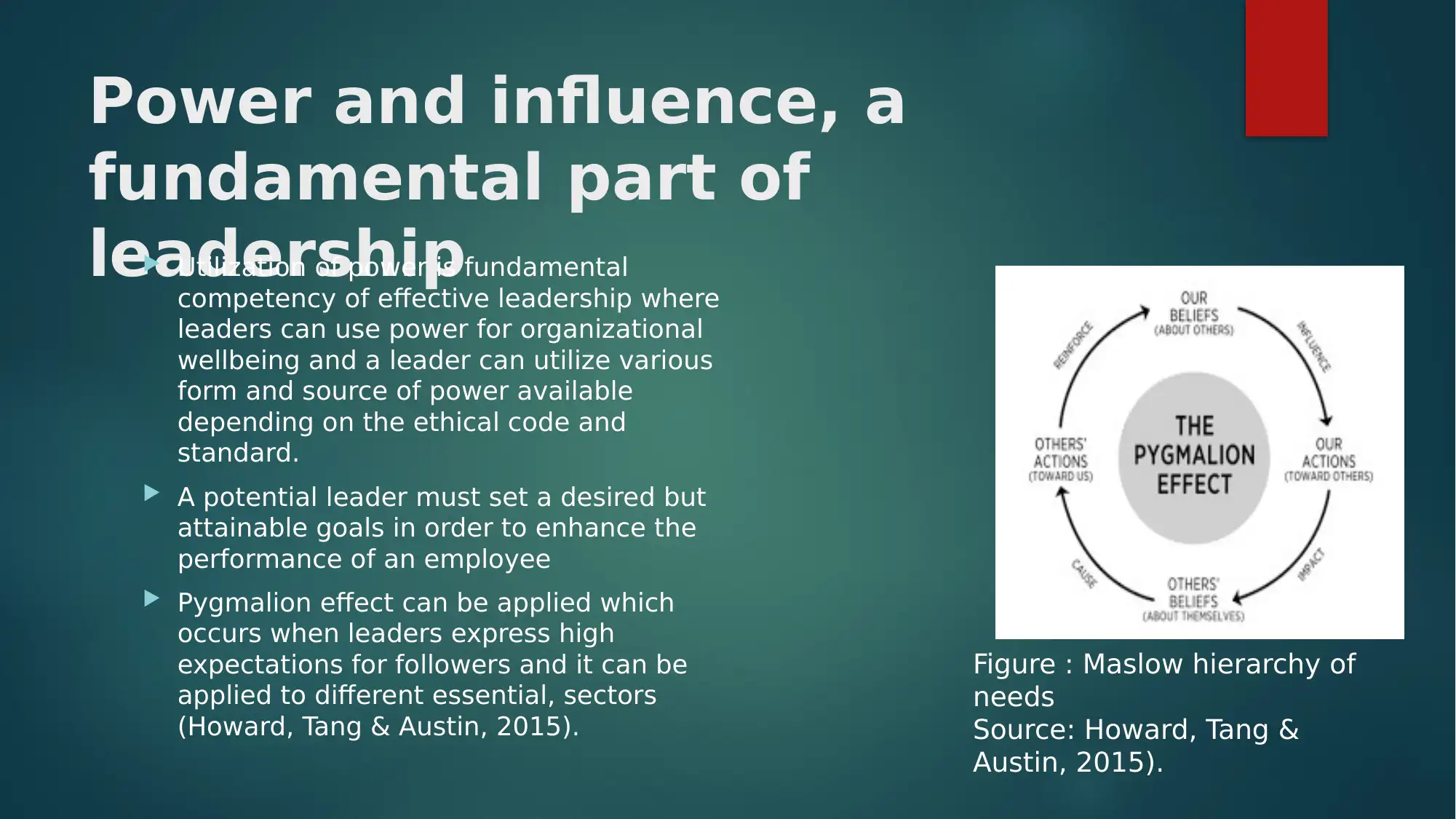
Power and influence, a
fundamental part of
leadership Utilization of power is fundamental
competency of effective leadership where
leaders can use power for organizational
wellbeing and a leader can utilize various
form and source of power available
depending on the ethical code and
standard.
A potential leader must set a desired but
attainable goals in order to enhance the
performance of an employee
Pygmalion effect can be applied which
occurs when leaders express high
expectations for followers and it can be
applied to different essential, sectors
(Howard, Tang & Austin, 2015).
Figure : Maslow hierarchy of
needs
Source: Howard, Tang &
Austin, 2015).
fundamental part of
leadership Utilization of power is fundamental
competency of effective leadership where
leaders can use power for organizational
wellbeing and a leader can utilize various
form and source of power available
depending on the ethical code and
standard.
A potential leader must set a desired but
attainable goals in order to enhance the
performance of an employee
Pygmalion effect can be applied which
occurs when leaders express high
expectations for followers and it can be
applied to different essential, sectors
(Howard, Tang & Austin, 2015).
Figure : Maslow hierarchy of
needs
Source: Howard, Tang &
Austin, 2015).
Paraphrase This Document
Need a fresh take? Get an instant paraphrase of this document with our AI Paraphraser
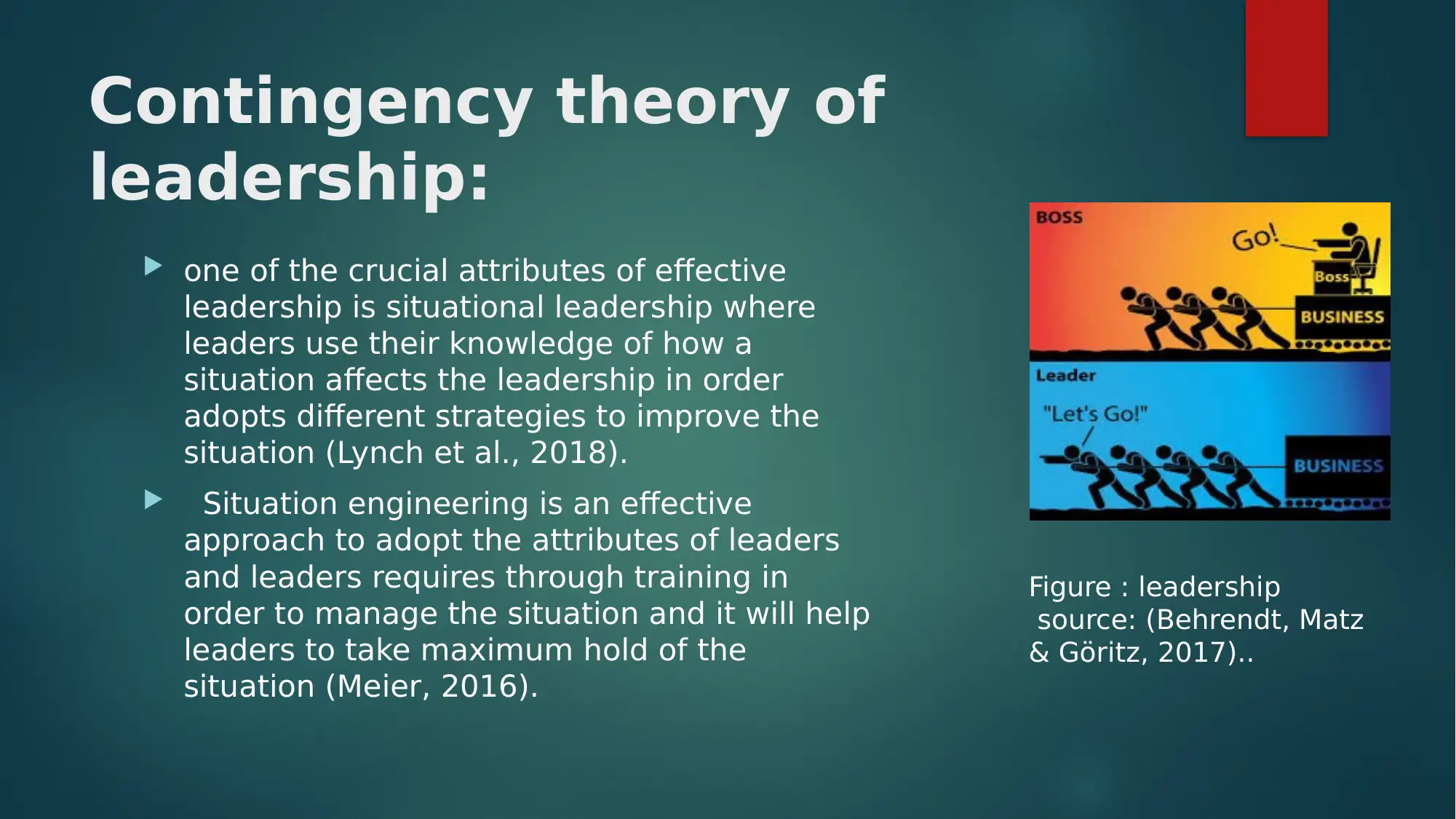
Contingency theory of
leadership:
one of the crucial attributes of effective
leadership is situational leadership where
leaders use their knowledge of how a
situation affects the leadership in order
adopts different strategies to improve the
situation (Lynch et al., 2018).
Situation engineering is an effective
approach to adopt the attributes of leaders
and leaders requires through training in
order to manage the situation and it will help
leaders to take maximum hold of the
situation (Meier, 2016).
Figure : leadership
source: (Behrendt, Matz
& Göritz, 2017)..
leadership:
one of the crucial attributes of effective
leadership is situational leadership where
leaders use their knowledge of how a
situation affects the leadership in order
adopts different strategies to improve the
situation (Lynch et al., 2018).
Situation engineering is an effective
approach to adopt the attributes of leaders
and leaders requires through training in
order to manage the situation and it will help
leaders to take maximum hold of the
situation (Meier, 2016).
Figure : leadership
source: (Behrendt, Matz
& Göritz, 2017)..
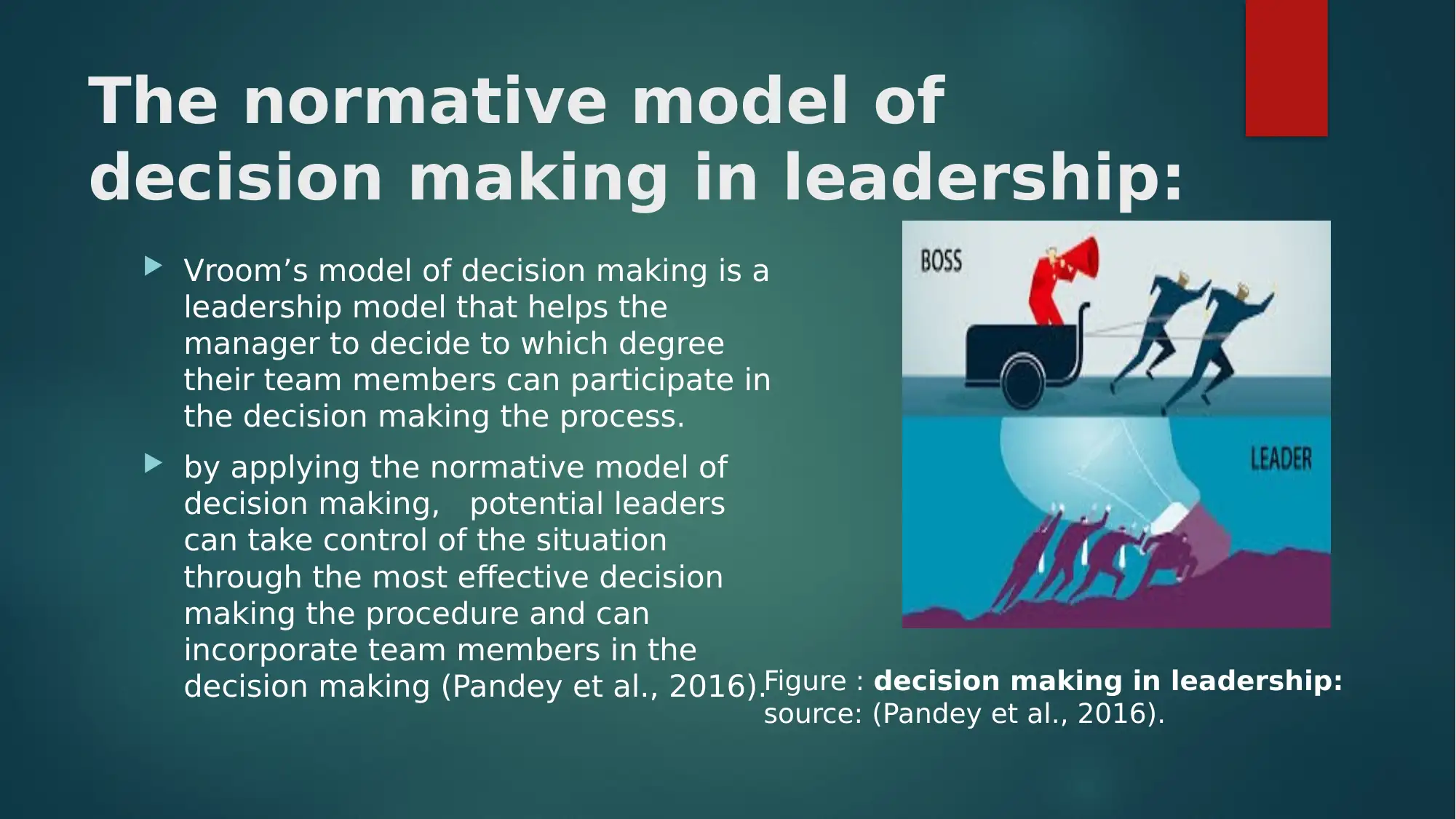
The normative model of
decision making in leadership:
Vroom’s model of decision making is a
leadership model that helps the
manager to decide to which degree
their team members can participate in
the decision making the process.
by applying the normative model of
decision making, potential leaders
can take control of the situation
through the most effective decision
making the procedure and can
incorporate team members in the
decision making (Pandey et al., 2016).Figure : decision making in leadership:
source: (Pandey et al., 2016).
decision making in leadership:
Vroom’s model of decision making is a
leadership model that helps the
manager to decide to which degree
their team members can participate in
the decision making the process.
by applying the normative model of
decision making, potential leaders
can take control of the situation
through the most effective decision
making the procedure and can
incorporate team members in the
decision making (Pandey et al., 2016).Figure : decision making in leadership:
source: (Pandey et al., 2016).
⊘ This is a preview!⊘
Do you want full access?
Subscribe today to unlock all pages.

Trusted by 1+ million students worldwide
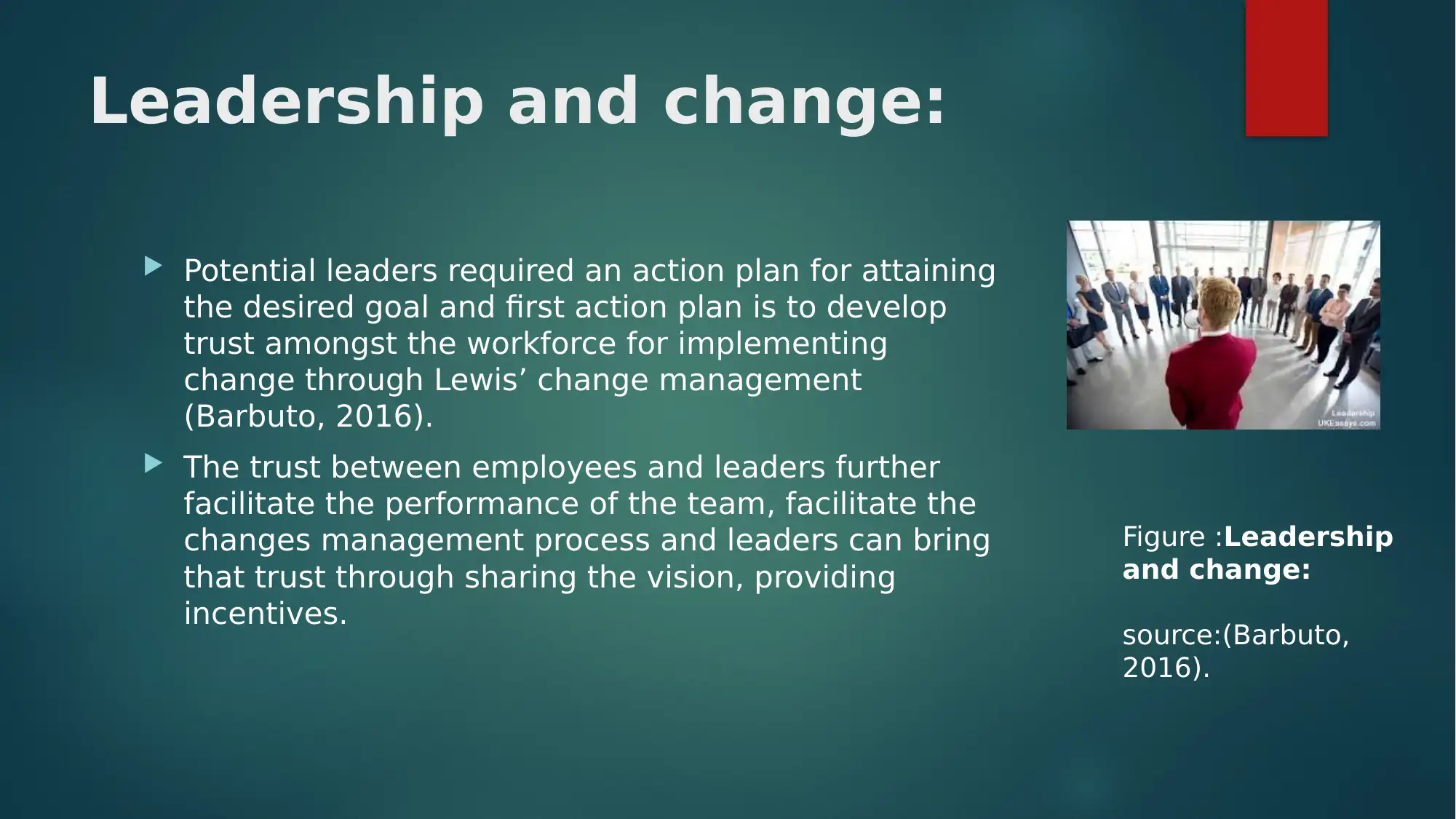
Leadership and change:
Potential leaders required an action plan for attaining
the desired goal and first action plan is to develop
trust amongst the workforce for implementing
change through Lewis’ change management
(Barbuto, 2016).
The trust between employees and leaders further
facilitate the performance of the team, facilitate the
changes management process and leaders can bring
that trust through sharing the vision, providing
incentives.
Figure :Leadership
and change:
source:(Barbuto,
2016).
Potential leaders required an action plan for attaining
the desired goal and first action plan is to develop
trust amongst the workforce for implementing
change through Lewis’ change management
(Barbuto, 2016).
The trust between employees and leaders further
facilitate the performance of the team, facilitate the
changes management process and leaders can bring
that trust through sharing the vision, providing
incentives.
Figure :Leadership
and change:
source:(Barbuto,
2016).
Paraphrase This Document
Need a fresh take? Get an instant paraphrase of this document with our AI Paraphraser
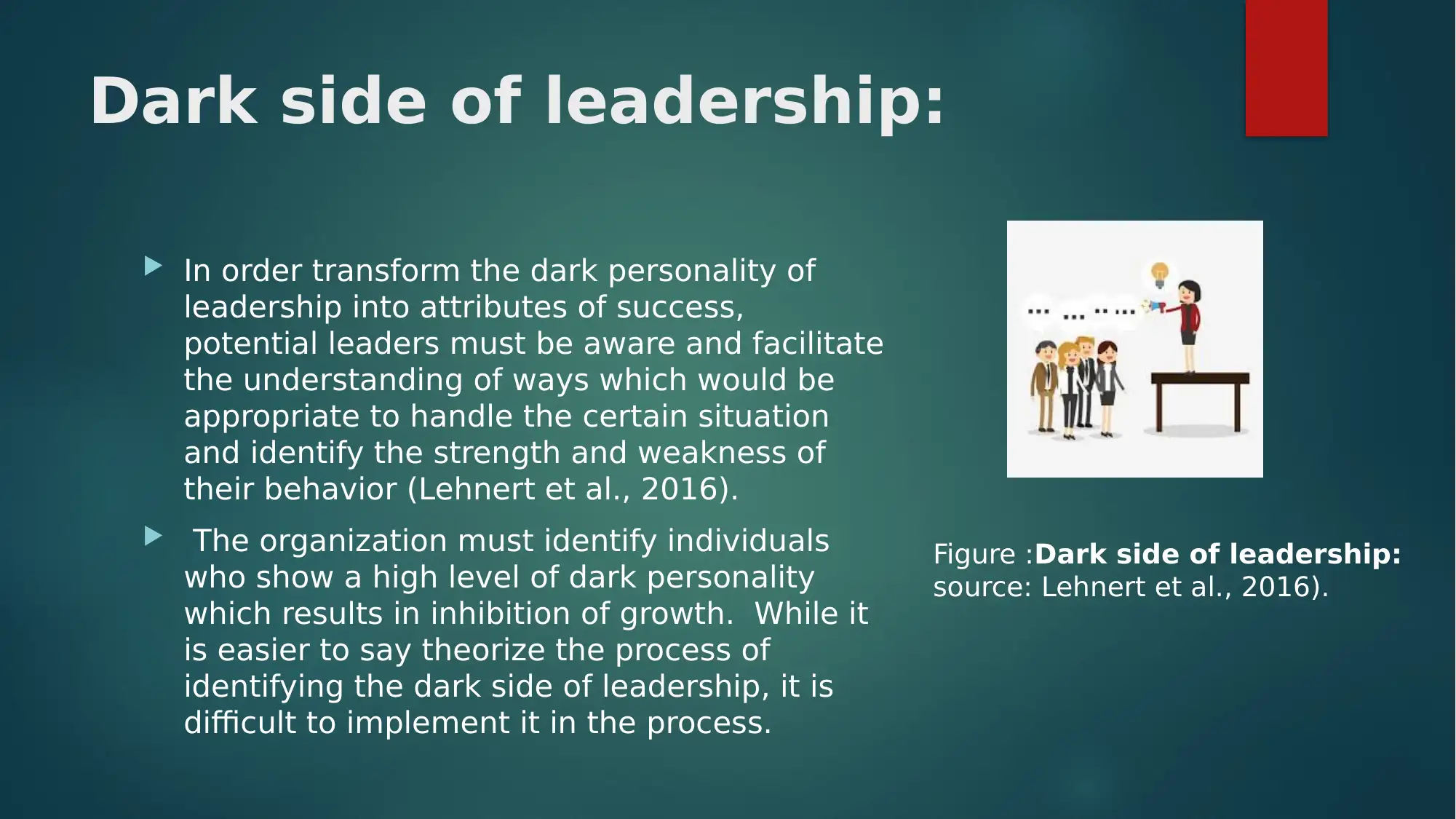
Dark side of leadership:
In order transform the dark personality of
leadership into attributes of success,
potential leaders must be aware and facilitate
the understanding of ways which would be
appropriate to handle the certain situation
and identify the strength and weakness of
their behavior (Lehnert et al., 2016).
The organization must identify individuals
who show a high level of dark personality
which results in inhibition of growth. While it
is easier to say theorize the process of
identifying the dark side of leadership, it is
difficult to implement it in the process.
Figure :Dark side of leadership:
source: Lehnert et al., 2016).
In order transform the dark personality of
leadership into attributes of success,
potential leaders must be aware and facilitate
the understanding of ways which would be
appropriate to handle the certain situation
and identify the strength and weakness of
their behavior (Lehnert et al., 2016).
The organization must identify individuals
who show a high level of dark personality
which results in inhibition of growth. While it
is easier to say theorize the process of
identifying the dark side of leadership, it is
difficult to implement it in the process.
Figure :Dark side of leadership:
source: Lehnert et al., 2016).
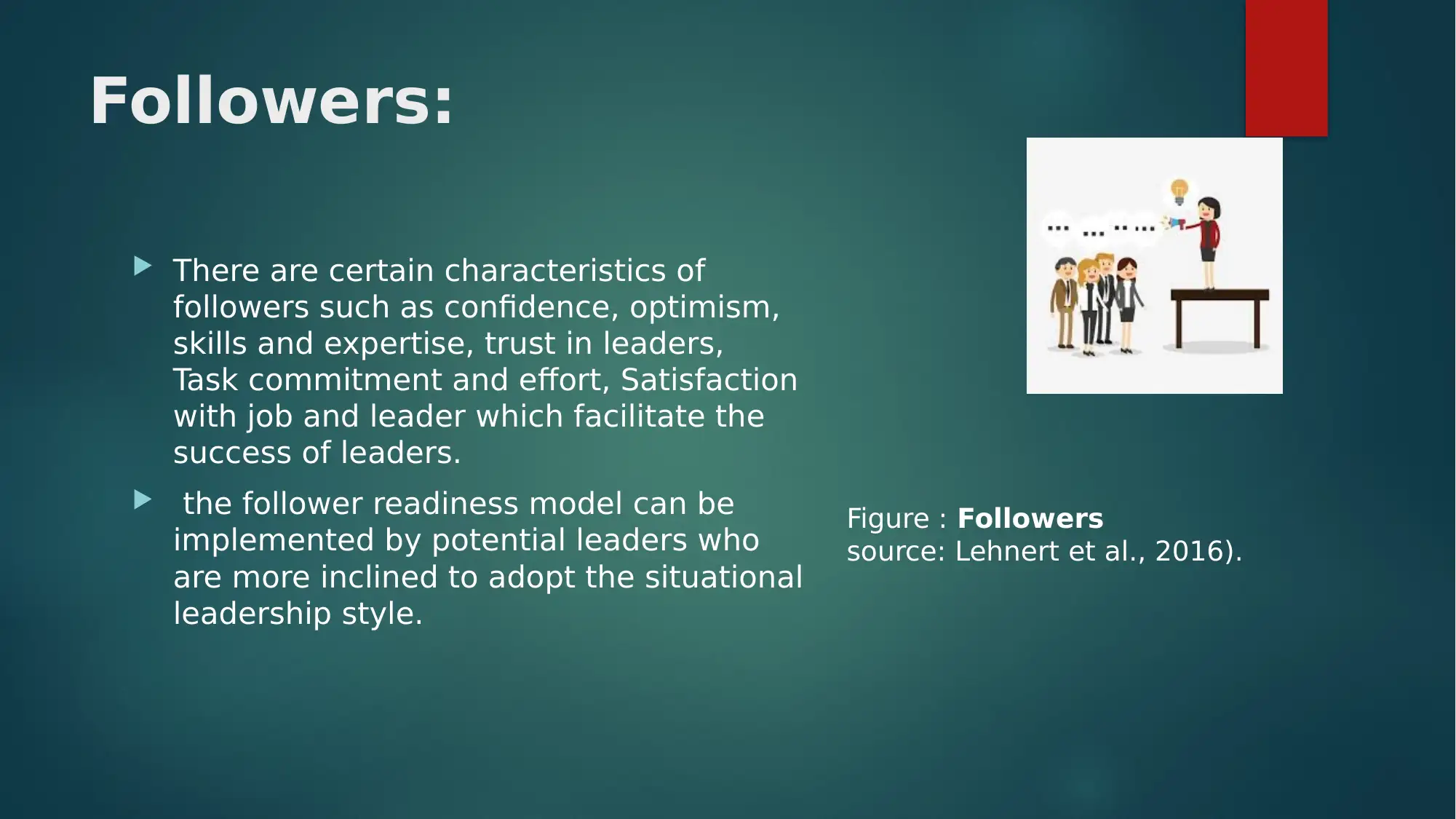
Followers:
There are certain characteristics of
followers such as confidence, optimism,
skills and expertise, trust in leaders,
Task commitment and effort, Satisfaction
with job and leader which facilitate the
success of leaders.
the follower readiness model can be
implemented by potential leaders who
are more inclined to adopt the situational
leadership style.
Figure : Followers
source: Lehnert et al., 2016).
There are certain characteristics of
followers such as confidence, optimism,
skills and expertise, trust in leaders,
Task commitment and effort, Satisfaction
with job and leader which facilitate the
success of leaders.
the follower readiness model can be
implemented by potential leaders who
are more inclined to adopt the situational
leadership style.
Figure : Followers
source: Lehnert et al., 2016).
⊘ This is a preview!⊘
Do you want full access?
Subscribe today to unlock all pages.

Trusted by 1+ million students worldwide
1 out of 15
Related Documents
Your All-in-One AI-Powered Toolkit for Academic Success.
+13062052269
info@desklib.com
Available 24*7 on WhatsApp / Email
![[object Object]](/_next/static/media/star-bottom.7253800d.svg)
Unlock your academic potential
Copyright © 2020–2025 A2Z Services. All Rights Reserved. Developed and managed by ZUCOL.





